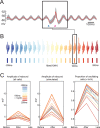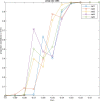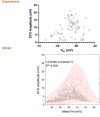How inhibitory and excitatory inputs gate output of the inferior olive
- PMID: 37526175
- PMCID: PMC10393294
- DOI: 10.7554/eLife.83239
How inhibitory and excitatory inputs gate output of the inferior olive
Abstract
The inferior olive provides the climbing fibers to Purkinje cells in the cerebellar cortex, where they elicit all-or-none complex spikes and control major forms of plasticity. Given their important role in both short-term and long-term coordination of cerebellum-dependent behaviors, it is paramount to understand the factors that determine the output of olivary neurons. Here, we use mouse models to investigate how the inhibitory and excitatory inputs to the olivary neurons interact with each other, generating spiking patterns of olivary neurons that align with their intrinsic oscillations. Using dual color optogenetic stimulation and whole-cell recordings, we demonstrate how intervals between the inhibitory input from the cerebellar nuclei and excitatory input from the mesodiencephalic junction affect phase and gain of the olivary output at both the sub- and suprathreshold level. When the excitatory input is activated shortly (~50 ms) after the inhibitory input, the phase of the intrinsic oscillations becomes remarkably unstable and the excitatory input can hardly generate any olivary spike. Instead, when the excitatory input is activated one cycle (~150 ms) after the inhibitory input, the excitatory input can optimally drive olivary spiking, riding on top of the first cycle of the subthreshold oscillations that have been powerfully reset by the preceding inhibitory input. Simulations of a large-scale network model of the inferior olive highlight to what extent the synaptic interactions penetrate in the neuropil, generating quasi-oscillatory spiking patterns in large parts of the olivary subnuclei, the size of which also depends on the relative timing of the inhibitory and excitatory inputs.
Keywords: gap junctions; inferior olive; mouse; neuroscience; oscillations; synaptic activity.
© 2023, Loyola, Hoogland et al.
Conflict of interest statement
SL, TH, HH, VR, MN, CD No competing interests declared
Figures



















Update of
- doi: 10.1101/2022.09.04.506491
Similar articles
-
Integration of Purkinje cell inhibition by cerebellar nucleo-olivary neurons.J Neurosci. 2015 Jan 14;35(2):544-9. doi: 10.1523/JNEUROSCI.3583-14.2015. J Neurosci. 2015. PMID: 25589749 Free PMC article.
-
Cerebellar Nuclei Neurons Show Only Small Excitatory Responses to Optogenetic Olivary Stimulation in Transgenic Mice: In Vivo and In Vitro Studies.Front Neural Circuits. 2016 Mar 24;10:21. doi: 10.3389/fncir.2016.00021. eCollection 2016. Front Neural Circuits. 2016. PMID: 27047344 Free PMC article.
-
Synaptic excitation by climbing fibre collaterals in the cerebellar nuclei of juvenile and adult mice.J Physiol. 2017 Nov 1;595(21):6703-6718. doi: 10.1113/JP274598. Epub 2017 Sep 20. J Physiol. 2017. PMID: 28795396 Free PMC article.
-
Gap junctions synchronize synaptic input rather than spike output of olivary neurons.Prog Brain Res. 2005;148:189-97. doi: 10.1016/S0079-6123(04)48016-9. Prog Brain Res. 2005. PMID: 15661191 Review.
-
The great gate: control of sensory information flow to the cerebellum.Cerebellum. 2002 Jan-Mar;1(1):27-34. doi: 10.1080/147342202753203069. Cerebellum. 2002. PMID: 12879971 Review.
Cited by
-
The cerebellum modulates thirst.Nat Neurosci. 2024 Sep;27(9):1745-1757. doi: 10.1038/s41593-024-01700-9. Epub 2024 Jul 10. Nat Neurosci. 2024. PMID: 38987435 Free PMC article.
-
Disynaptic Inhibitory Cerebellar Control Over Caudal Medial Accessory Olive.eNeuro. 2024 Feb 16;11(2):ENEURO.0262-23.2023. doi: 10.1523/ENEURO.0262-23.2023. Print 2024 Feb. eNeuro. 2024. PMID: 38242692 Free PMC article.
-
Switching neuron contributions to second network activity.J Neurophysiol. 2024 Feb 1;131(2):417-434. doi: 10.1152/jn.00373.2023. Epub 2024 Jan 10. J Neurophysiol. 2024. PMID: 38197163 Free PMC article.
-
Control of action potential afterdepolarizations in the inferior olive by inactivating A-type currents through KV4 channels.J Physiol. 2024 Sep 20:10.1113/JP286818. doi: 10.1113/JP286818. Online ahead of print. J Physiol. 2024. PMID: 39303148
-
Terra Incognita - Contributions of the Olivo-Cerebellar System to Autism Spectrum Disorder.Cerebellum. 2025 May 2;24(4):93. doi: 10.1007/s12311-025-01843-w. Cerebellum. 2025. PMID: 40316858 Review.
References
Publication types
MeSH terms
Associated data
Grants and funding
LinkOut - more resources
Full Text Sources
Molecular Biology Databases
Miscellaneous

